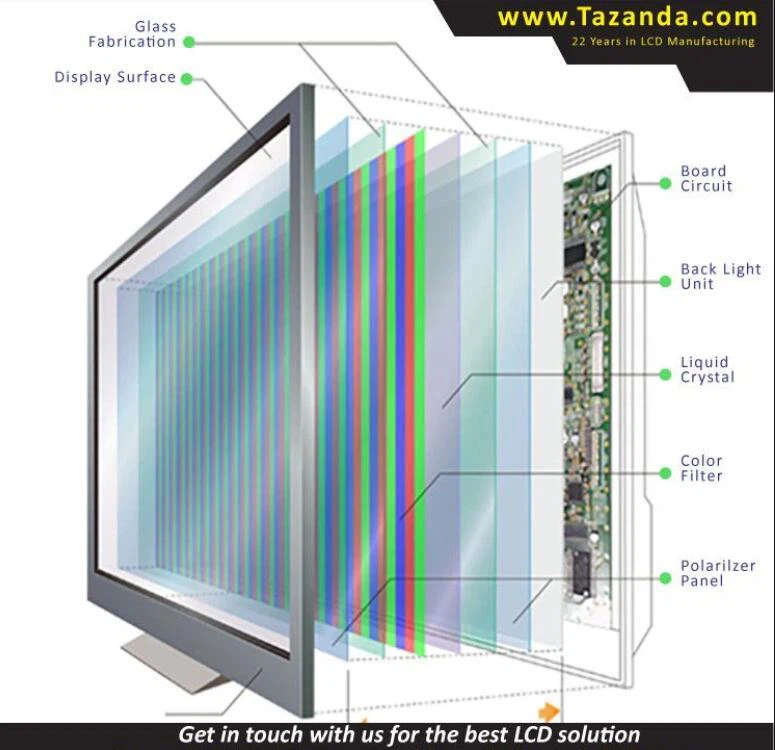The American inventor J. Fergason created the first working liquid crystal display in 1970. Before that, such devices consumed too much energy, their operating life was limited, and the contrast of the image was on a low level. A new LCD monitor was introduced in 1971. Despite the fact that liquid crystals were discovered a long time ago, at first, they were applied for different purposes. Molecules of liquid crystals under the influence of electricity can change their orientation and, as a result, change the properties of the light beam passing through them. Based on this discovery and because of further research, it became possible to discover a connection between the increase of electric voltage and the change in the orientation of the crystal molecules to ensure the creation of the image. Firstly, liquid crystals found their application in the displays for calculators and quartz watches, and then they were utilized in monitors. Today, due to progress in this area, such screens have become very popular in all types of products that needs a visual output and a clear understanding of what's going on.
LCD screens are an array of small segments called pixels, which can be manipulated for information displaying. Such displays have several layers, where two panels, made of glass material free of sodium and called substrate, play a crucial role. The substrate contains a thin layer of liquid crystals between them. The panels have flutes that direct the crystals, giving them a distinctive orientation. Flutes are parallel on each panel but are perpendicular between the two of them. Longitudinal flutes are obtained as a result of placing on the glass surface thin films of transparent plastic, which are then processed in a particular way. In contact with the flutes, the molecules are oriented identically in all the cells. The liquid crystal panel is illuminated by a light source, depending on where it is located, as the LCD panels operate on reflection or light transmission. The plane of polarization of the light beam is rotated by 90° as one panel passes. When an electric field appears, the molecules are partially aligned along it, and the angle of rotation of the plane of polarization of light becomes different from 90°. By producing screens using LCD monitor technology, the backlight of the monitor is used to output a color image so that light is generated at the back of the LCD monitors. It is necessary to be able to have a picture with good quality, even if it is dark. The color is obtained using three filters, which distinguish three principal components from the radiation of a white light source. By combining the three primary colors for each pixel of the screen, you can reproduce any color.
Modern LCD screens are also called flat panels, dual scan active matrix, and thin-film transistors. Now they are extremely popular - everyone likes their elegant look, thinness, compactness, and efficiency. LCD monitors provide a quality contrast, and bright, clear images. In the past, liquid crystal technology was slow, not as efficient as now, and their contrast level was low. The first matrix technologies, the so-called passive matrices, worked quite well with textual information, but with a sharp change in the picture, so-called "ghosts" appeared on the screen. Since LCD technology orients each pixel separately, the clarity of the received text is higher in comparison with CRT monitors, which in the past could compete with LCD ones. Now, of course, with the development of technology and taking into account the overall technological process, liquid crystal monitors have long been ahead and occupy a leading position among the displays used for various applications. Monitors based on liquid crystals are widely utilized not only in desktop computers but also in an array of electronic devices: TVs, photo and video cameras, laptops, tablets, smart-phones, car navigators, e-books, MP3 and other players, watches, etc.
Now LCD plays the most important role in any device that needs a nice and clear presentation. If you are working on a device and want to show the visual presentation to the audience LCD is a great solution for you.
Whatever products you are developing- medical monitoring device, or wearable device or industrial device- anything you can think of. From the range of 1 inch to as long as you can imagine.
With LCD screen you can use less power, get high resolution output and a clear and nice presentation.
We, Shenzhen Tianzhengda, can help you select the best display for your product whereas it's TN or IPS or you don't have any idea what to use.
We can help you to select the best as per your requirement and can provide the best product in the market. Our products are hugely trusted by big names like Honeywell, Verifone, Longwood, TOPBAND, VIOMi and other big brands around the world.
Please let us know your requirements, and we will get back to you with the best and latest solution for your project. Our LCDs are using various sector like financial POS system, Home appliance, PDA, Automotive display, Medical instruments display, Military industry and IOT, industrial sector and many more. Get in touch with us at betty@lcdstar.com
We are ready to answer your any questions related to LCD and are ready to work together with your next project whereas it's a 2.4 inch TN display project or a 10.1 Inch medical display project.
